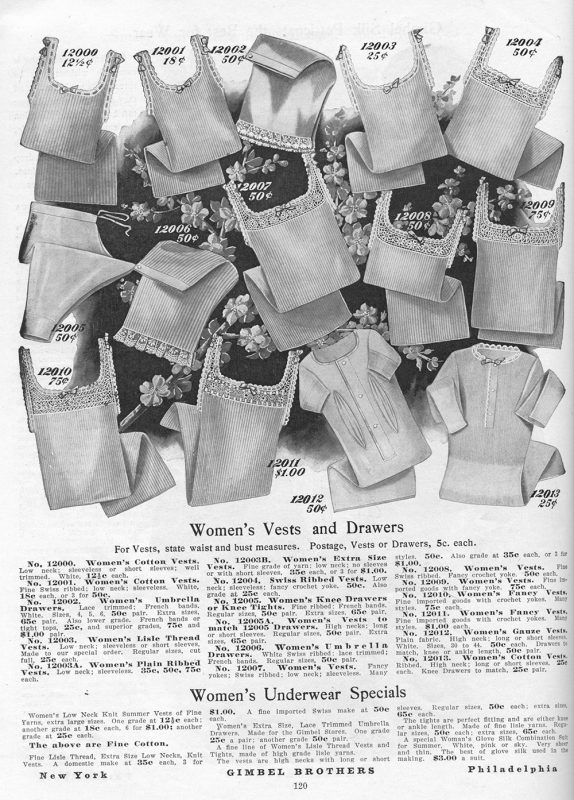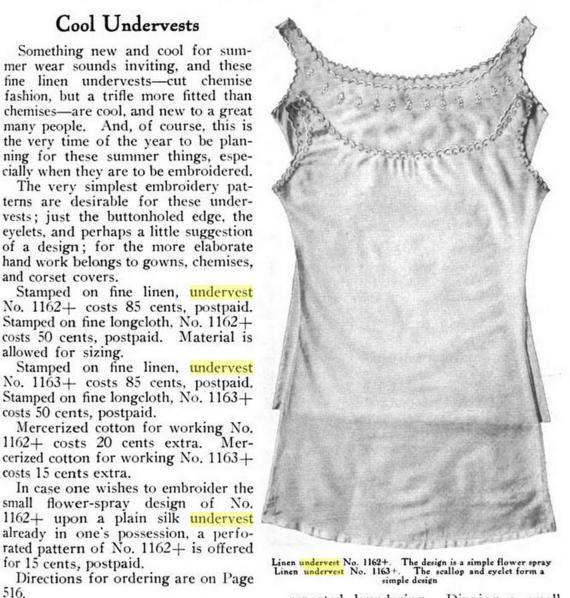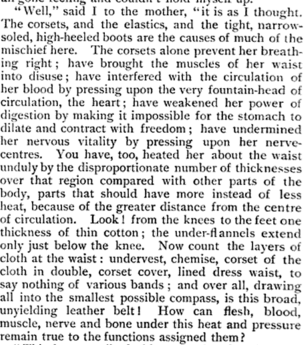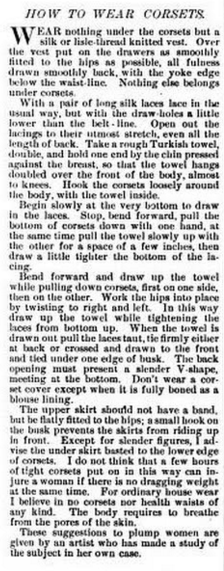I have a hypothesis that’s been a long time coming. It started by observing advertisements in old magazines, then spotting articles in my old catalogs. Finally I gave up, did a search, and I am starting to believe my feeling is correct. In simple terms- I may have been more period correct than I knew when I wore my long knit tank tops under my corset in place of a chemise.
Now, don’t get me wrong. I love a good ol’ chemise just like any other die-hard historical addict. But sometimes it’s hot. Sometimes it’s bulky (even if of fine fabric). Sometimes the neckline shows unfavorably under the gown or blouse. And that’s when the tank top comes to the rescue.
It was my dirty little secret. I love historical accuracy and I didn’t share it except when I found others who “cheated”, too.
And then I found this. Gimbel Brothers Spring/Summer 1911 catalog:
And so I start my little search. This is still ongoing, but here’s what I’ve found so far.
There WERE things called “undervests.” In fact, it looks like for a while the chemise was considered “old fashioned.” And then, in the 19-teens, when “old fashioned” was La Mode again, the chemise made a resurgence.
Think of it like this- you’ve got a piece of clothing you love. You keep your clothing. You wear it. The company still may even make it, even if it’s considered to be out of fashion. And then Dame Fashion says it’s in vogue again, and you can proudly wear your article of clothing and claim you never gave it up. And you’re cool again. Chemises are kind of like that, from what I’ve been reading.
“The chemise is greatly worn. Many women have never abandoned it for any of the more snugly fitted combinations, and during the large-waisted, straight-figure era it has been as well suited to the situation as anything, provided, of course, it is made of very fine soft material so that it will give no bulkiness about the hips.
A chemise vest has found considerable favor as a substitute for the more closely clinging undervest, and is merely a chemise cut short to ordinary undervest length. It is made in lingerie or crepe and may be trimmed as daintily as any chemise about the top, presenting a much daintier appearance when the corset cover is off than any ordinary undervest does.
Another new model in undervests comes in the shape of an ‘under and over’ combination of italian or glove silk. It consists of knickers associated with two upper sections- one of which goes under the corset and one over. Perhaps a better idea of the thing can be conveyed by describing it as a vest and knicker combination, which has attached to it a brassiere or corset cover that can be drawn down over the corset and drawn in snugly at the waistline. The vest and cover have only single shoulder straps, but otherwise are separate, and the elimination of the extra shoulder strap, with the added neatness secured in this way, recommends this combination to many women.”
From The Corset and Underwear Review, 1915. Page 81-82.
But undervests could be knit or they could be woven. The important thing seems to be that they are fitted snugly and they are of fine fabrics, so as to not create bulk. They end shortly below the corset. Notice how short they are in the articles below:
“The undervest worn inside the corsets must also fit the body closely, and unless it is of fine texture it is apt to chafe and irritate the skin.”
From the Delineator, 1911.
From Good Housekeeping, 1911.
The underwear fashions moved SO QUICKLY in the early part of the 20th century. There were endless combinations of what you could wear (including combinations… yuk yuk). This year everyone needs combinations that had wide legs. In five years, everyone wants narrow legs. There was even a short time span when bloomers with drawn in legs (like the old cartoons), and hoop skirts came back. No, really, look it up. It’s no joke.
But I digress… back to the tank tops… err.. I mean under vests (which could or could not have sleeves, by the way. The extra fashionable ones seemed to have convertible straps for a while so they could go from day to evening).
From “Wide Awake”, 1885, page 92:
“… count the layers of cloth at the waist: undervest, chemise, corset of the cloth in double, corset cover, lined dress waist, to say nothing of various bands…”
But just a little later and I find my definitive answer. Harper’s Bazaar, 1897- page 845.
“Wear nothing under the corsets but a silk or lisle-thread knitted vest. Over the vest put on the drawers as smoothly fitted to the hips as possible, all fulness drawn smoothly back, with the yoke edge below the waistline. Nothing else belongs under corsets.”
Well, there it is in black and white. Sure, a little earlier than the era I was looking for originally, but it was a standard option. Why else would the under vests continue to be mentioned?
And then it starts making sense…
“Korso is positively the only undervest which can be comfortably worn with evening gowns and summer waists. By simply folding it over the top of the corset, it is changed into a dainty corset cover which leaves the neck and shoulders absolutely free and does away with stuffing the undervest into the corset.”
The Dry Goods Reporter, 1902.
And I am still finding even more mentions of them. I’ve even found mentions of women’s union suits being worn under corsets because the buttons are small enough to prevent rubbing. But, of course, I forgot to bookmark that find.
So why did they go out of fashion? Well, it seems women started favoring chemises again because the undervests were so short that they were continually having to tug them down under the newer long-line corsets. The knit combination suits stuck around for a while, though!
So what do you think? Does this change your perception of what historical underwear was like? I don’t know about you, but I’m going to make a period appropriate knit undervest and wear it with pride!







Quinn
February 3, 2018 at 9:06 am (6 years ago)Fascinating observation and research! It’s so lovely to find out that you’ve been onto an idea that made sense and was actually in practice in the past. Well done, and thank you for sharing with us.
Best,
Quinn
Michaela
February 9, 2018 at 2:01 pm (6 years ago)I seriously want to make one now! Thank you for the research!
Hana - Marmota
February 11, 2018 at 9:39 am (6 years ago)Fascinating! For me, because this isn’t my usual era, from one particular point of view:
Back in the last year of grammar school, I did a history paper examining the historical accuracy or lack thereof in “Once Upon a Time in the West”. One part of the problem was even determining when it’s supposed to take place, because what with its being a bit of a mythical western story, it’s a bit all over the place. Well, long story short, one thing I was puzzled by in terms of fashion is the clearly knit (because form-fitting and ribbed) thing the character Jill wears under her corset. (Which also happens to be an under-bust corset worn under dresses two of which at least look more 1840s than anything else, therefore way too early for the transcontinental railroad plot; but that’s a whole different matter. Which mostly now serves to remind me that my reading costuming blogs and trawling the internet for pictures of extant dresses definitely started earlier than I have recently thought…)
Anyway – I thought it was a modern filmmaking shortcut which was slightly disappointing because despite the film being all over the place, it was rather clear the filmmakers usually based everything in it on *something*. So it’s nice to see years after the fact that they probably did even in this case!